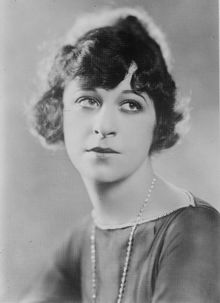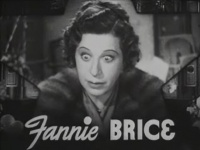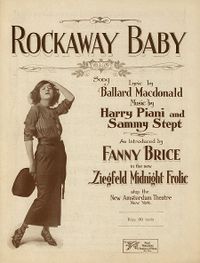Fanny Brice
Click here for Burlesque History page |
Fanny Brice (✦October 29, 1891 – †May 29, 1951) was a popular and influential American comedienne, singer, theatre and film actress and entertainer, remembered best for her many stage, radio and film appearances and her gramophone recordings. She was the creator and star of the top-rated radio comedy series, The Baby Snooks Show.
17 years after her death, she was portrayed on stage and film by Barbra Streisand in Funny Girl.
Early life
Fanny Brice (occasionally spelled Fannie) was the stage name of Fania Borach, born in New York City, the third child of relatively well-off saloon owners of Hungarian Jewish descent. In 1908, she dropped out of school to work in a burlesque revue, and two years later she began her association with Florenz Ziegfeld, headlining his Ziegfeld Follies from 1910 into the 1930s.
In the 1921 Follies, she was featured singing "My Man" which became both a big hit and her signature song. She made a popular recording of it for Victor Records. The second song most associated with her is "Second Hand Rose". She recorded nearly two dozen record sides for Victor and also cut several for Columbia. She is a posthumous recipient of a Grammy Hall of Fame Award for her 1921 recording of "My Man".
Her films include My Man (1928), Be Yourself! (1930) and Everybody Sing (1938) with Judy Garland. Brice, Ray Bolger, and Harriet Hoctor were the only original Ziegfeld performers to portray themselves in The Great Ziegfeld (1936) and Ziegfeld Follies (1946). For her contribution to the motion picture industry, she has a star on the Hollywood Walk of Fame at MP 6415 Hollywood Boulevard.
Career
From the 1930s until her death in 1951, Fanny made a radio presence as a bratty toddler named Snooks, a role she first premiered in a Follies skit. With first Alan Reed and then Hanley Stafford as her bedeviled Daddy, Baby Snooks premiered in The Ziegfeld Follies of the Air in February 1936 on CBS. She moved to National Broadcasting Company (NBC) in December 1937, performing the Snooks routines as part of the Good News show, then back to CBS on Maxwell House Time, the half-hour divided between the Snooks sketches and comedian Frank Morgan, in September 1944. She was back to NBC in November 1948, in a full show of her own, first called Toasties Time but soon known as The Baby Snooks Show.
Brice was so meticulous about the program and the title character that she was known to perform in costume as a toddler girl even though seen only by the radio studio audience. She was 45 years old when the character began her long radio life. In addition to Reed and Stafford, her co-stars included Lulu Roman, Lalive Brownell, Lois Corbet, and Arlene Harris playing her mother, Danny Thomas as Jerry, Charlie Cantor as Uncle Louie, and Ken Christy as Mr. Weemish. She was completely devoted to the character, as she told biographer Norman Katkov: "Snooks is just the kid I used to be. She's my kind of youngster, the type I like. She has imagination. She's eager. She's alive. With all her deviltry, she is still a good kid, never vicious or mean. I love Snooks, and when I play her I do it as seriously as if she were real. I am Snooks. For 20 minutes or so, Fanny Brice ceases to exist."
Baby Snooks writer Everett Freeman told Katkov that Brice didn't like to rehearse the role but always snapped into it on the air, losing herself completely in the character: "While she was on the air she was Baby Snooks. And after the show, for an hour after the show, she was still Baby Snooks. The Snooks voice disappeared, of course, but the Snooks temperament, thinking, actions were all there."
Brice had a short-lived marriage in her teens to a local barber, Frank White. Her second husband was professional gambler Julius "Nicky" Arnstein. Prior to their marriage, Arnstein served 14 months in Sing Sing for wiretapping where Brice visited him every week. In 1918 they were married after living together for 6 years. In 1924, Arnstein was charged with a Wall Street bond theft. Brice insisted on his innocence and funded his legal defense, at great expense. Arnstein was convicted and sentenced to the Federal penitentiary at United States Penitentiary, Leavenworth where he served 3 years. Released in 1927, the ungrateful and unfaithful Arnstein disappeared from Brice's life and that of his two children. Reluctantly, Brice divorced him. She went on to marry songwriter and stage producer Billy Rose and appeared in his revue Crazy Quilt, among others. Unfortunately, that marriage also failed.
Brice and Stafford brought Baby Snooks and Daddy to television only once, an appearance in 1950 on CBS-TV's Popsicle Parade of Stars. This was Fanny Brice's only appearance on television. Viewing the kinescope recording today, Fanny is a strange, but amusing sight: a middle-aged woman in a little girl's outfit (and none of the other cast seemed to find this unusual). Brice handled herself well on the live TV broadcast but later admitted that the character of Baby Snooks just didn’t work properly when seen. She returned with Stafford and the Snooks character to the safety of radio for her next appearance, on Tallulah Bankhead's legendary big-budget, large-scale radio variety show, The Big Show (NBC Radio), in November 1950, sharing the bill with Groucho Marx and Jane Powell. In one routine Snooks knocks on Bankhead's dressing room door for advice on becoming an actress when she grew up in spite of Daddy's warning that she already lacked what it took.
Six months after her Big Show appearance, Fanny Brice died in Hollywood at the age of 59 of a cerebral hemorrhage.
She is interred in the Westwood Village Memorial Park Cemetery in Los Angeles. The May 29 1951] episode of The Baby Snooks Show was broadcast as a memorial to the star who created the brattish toddler, crowned by Hanley Stafford's brief on-air eulogy: "We have lost a very real, a very warm, a very wonderful woman." Her original interment was located at Home of Peace Cemetery and Memorial Park.
Brice portrayals
Although the names of the principal characters were changed, the plot of the 1939 film Rose of Washington Square was inspired heavily by Brice's marriage and career, to the extent it borrowed its title from a tune she performed in the Follies and included "My Man." She sued 20th Century Fox for invasion of privacy and won the case. Producer Darryl F. Zanuck was forced to delete several production numbers closely associated with the star.
Barbra Streisand starred as Brice in the 1964 Broadway theatre musical Funny Girl, which centered on Brice's rise to fame and troubled relationship with Arnstein. In 1968, Ms. Streisand won the Academy Award for Best Actress for reprising her role in the film version. The 1975 sequel Funny Lady focused on Brice's turbulent relationship with impresario Billy Rose and was as highly fictionalized as the original. Streisand also recorded the Brice songs "My Man," "I'd Rather Be Blue Over You (Than Happy with Somebody Else)" and "Second Hand Rose," which became a Top 40 hit.
Funny Girl and Funny Lady are examples of how plays and films take great liberties with the lives of historical figures and/or events. The Streisand film makes no mention of Brice's first husband at all. It also suggests that Arnstein turned to crime because his pride wouldn't allow him to live off Fanny; the real Nicky shamelessly sponged off her. The film suggests Nicky sold phony bonds; he was actually part of a gang that stole $5 million of Wall Street securities. Instead of turning himself in, as in the movie, Arnstein went into hiding. When he finally surrendered, he did not plead guilty, as he did in the movie, but fought the charges for four years, taking a toll on his wife's finances.
Two children were born of the Brice-Arnstein marriage but only one is depicted in the film. Daughter Frances (1919-1992) married Ray Stark (1915-2004), producer of both the Broadway musical and the film, while son William (1921-2008) became an artist of note.
Fanny Brice had a long and successful collaboration with Irving Berlin that is never mentioned. Many of the events depicted in Funny Lady are extreme exaggerations of the truth or outright fabrications.
Trivia
- Starred in every Ziegfeld Follies on Broadway from 1910 until 1936.
- Starred in the widely popular 1940s U.S. radio comedy series as its title character, "Baby Snooks".
- Pictured on one of five 29¢ U.S. commemorative postage stamps celebrating famous comedians, issued in booklet form 29 August 1991. The stamp designs were drawn by caricaturist Al Hirschfeld. The other comedians honored in the set are Stan Laurel and Oliver Hardy; Edgar Bergen (with alter ego Charlie McCarthy); Jack Benny; and Bud Abbott and Lou Costello.
- Believed that pearls should not be taken off and needed to be lived in, so she would sleep in hers at night.
- Barbra Streisand played her in the musical Funny Girl (1968) and the sequel Funny Lady (1975).
- Children with Arnstein: Frances (August 12, 1919-May 31, 1992) and famed abstract artist/painter William (April 23, 1921-March 3, 2008). Mother-in-law of Ray Stark.
- Following her death, she was interred in the Chapel Mausoleum at the Home of Peace Cemetery in Los Angeles, California.
- Following the death of her daughter Frances, she was reinterred at Westwood Memorial Park Cemetery in Los Angeles, California.
- The birth name of her second husband, better known as Nick Arnstein, was actually Jules W. Arndt Stein.
- Dropped out of school after the eighth grade to work in a burlesque revue, "The Girls from Happy Land Starring Billy Watson". (12/31/37) Radio: Appeared in MGM production of "Good News of 1938" on NBC Network. Also in cast: Myrna Loy, James Stewart, Wallace Beery, Bruce Cabot, Frank Morgan, Freda Starr, Gilbert Russell, Judy Garland, Dennis O'Keefe, Lewis Stone, Guy Kibbee, and Cliff Edwards.
She was awarded 2 Stars on the Hollywood Walk of Fame: for Motion Pictures at 6415 Hollywood Boulevard and for Radio at 1500 Vine Street in Hollywood, California.
- Profiled in the book "Funny Ladies: 100 Years of Great Comediennes" by Stephen M. Silverman (1999).
Returned to work two months after giving birth to her daughter Frances in order to begin performing on the Broadway production of "Ziegfeld Midnight Frolic".
- Returned to work two months after giving birth to her son William in order to begin performing on the Broadway production of "Ziegfeld Follies of 1921".
- Was three months pregnant with her son William when she ended her run on the Broadway production of "Ziegfeld Follies of 1920".
- Became pregnant by her future husband Nick Arnstein prior to his divorce and their 1919 marriage, but she had an abortion.
References
- Goldman, Herbert, Fanny Brice: The Original Funny Girl, Oxford University Press, 1993, isbn 0-19-508552-3.
- Grossman, Barbara, Funny Woman: The Life and Times of Fanny Brice, Indiana University Press, 1992, isbn 0-253-20762-2.
Clips to watch
External links
- https://www.musicals101.com/brice.htm Funny Girl Debunked: Fanny Brice Facts by John Kenrick
- http://www.brice.nl/bricehome.html Fanny Brice Collection
- http://www.jewishvirtuallibrary.org/jsource/biography/brice.html Jewish Virtual Library: Fanny Brice
- Fanny Brice at the Internet Broadway Database
- Review Review Fanny Brice on Internet Movie Database
- A Dutch site (in English)
- Baby Snooks playlist on YouTube.com
- Funny Girl Debunked: Fanny Brice Facts - by John Kenrick
- Fanny Brice @ Find A Grave
Chat rooms • What links here • Copyright info • Contact information • Category:Root


